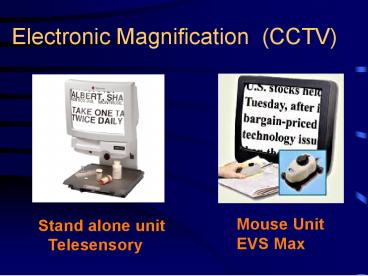Electronic Magnification CCTV PowerPoint PPT Presentation
1 / 23
Title: Electronic Magnification CCTV
1
Electronic Magnification (CCTV)
Mouse Unit EVS Max
Stand alone unit Telesensory
2
Flipper port EVS
Videoeye Swing Arm
Max port Head Worn
3
Electronic Magnification
- Advantages
- Can significantly increase size
- Controls for contrast and glare
- Portable depending on model
- Versatile
- Permits binocular use of eyes
- Preserves field of view
4
Electronic Magnification
- Disadvantages
- Expensive
- 350 and up
- Cheaper models are not portable
- Can be difficult to wear and to position
- Higher cognitive demand
- Sometimes difficult to tolerate motion
- Perceived as high tech by older users
5
Patients should always wear their eyeglasses when
using any magnifier
- Eyeglasses correct for refractive errors
- Hand held magnifier should be viewed through
DISTANCE CORRECTION - Stand magnifier should be viewed through READING
ADD
6
Telescopes
- Used to view objects at a distance
- Have different focusing ranges
- Afocal
- Focuses beyond 20 feet
- Reading cap
- Permits focusing distance of 16-18 inches
7
Telescope Design
Objective lens
Ocular lens
8
Exit pupil is the optical window the patient
views through
Exit pupil
Higher the magnification, the smaller the exit
pupil
9
Telescopes Come in Two Basic Styles
- Galilean
- Used for most low vision
- Smaller and lighter weight
- Keplerian
- Astronomical telescope
- Has a larger exit pupil
- But weighs more
10
Strength of Telescopes
- Label indicates power and field of view
- Example
- 6 x 30 telescope
- 6x power and a 30mm objective lens
11
Challenges Using Telescopes
- Motion Parallax
- Movement is exaggerated through the telescope
- Creates a speed smear (described as bouncing)
when used in dynamic situation - Difficult to adjust to, reduces accuracy
12
Challenges cont.
- Objects appear closer than they really are
- Generally the field of view is very small unless
the magnifier is really bulky - Lose light- images appear darker
13
For maximum image brightness, the exit pupil
should match the patients pupil
- To determine the size of the exit pupil
- Divide the diameter of the objective lens by the
power of the magnifier - Example
- 6 x 30 magnifier
- 30 5 mm
- 6
14
- Measure the width of the patients pupil using a
metric ruler and compare - If the exit pupil is smaller than the patients
pupil, the image will be dark - To correct-try a telescope with a larger exit
pupil
15
Clip-on Monocular
- For short term or periodic telescopic needs
16
Bioptic (for continuous use)
- Used in combination with carrier lens
- Carrier is used for most activities-bioptic for
detail - Dip head to view through biotic
- Limited field, motion parallax
17
Full Field Binocular
- Covers entire lens in frame
- often used to view sporting events /TV
- sportscopes
- Doesnt allow viewer to look around
- Can only use when stationary
- Heavy-can be hard on nose bridge and ears
18
Clip on monocular
Head worn binocular
19
Automatic Focusing Telescopes
Monocular
Binocular
from Ocutech
20
Some persons can be fitted with a contact lens
system
- High minus power serves as the ocular lens
- Plus spectacle worn as the objective lens
- Provides a 50 degree visual field with 2x
magnification
21
Miscellaneous stuff.
- Monocular telescope powers
- 2.5x, 2.8x, 3x, 4x, 6x, 8x, 10x
- Spectacle powers
- 2x, 2.2x, 3x, 4x, 6x, 8x
- For monoculars, person should always wear glasses
unless instructed not to - Correct for astigmatism
22
Telemicroscope
- Combination microscope and telescope
- Usually spectacle mounted
- Generally a microscope cap is placed on a
telescope lens - Gives advantage of microscope magnification at a
longer focal distance
23
Telemicroscope

